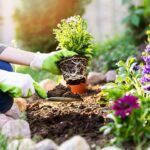Water, the elixir of life for plants, plays a pivotal role in the success of your indoor garden. Mastering Indoor Gardening Watering goes beyond a casual splash; it’s the art of understanding your plant’s hydration needs and providing the right balance. In this guide, we’ll embark on a journey to discover the intricacies of watering, ensuring your indoor oasis flourishes with vitality.
Hydration Harmony: Understanding Your Plants’ Needs
Knowing Your Plant’s Thirst Level
Just like humans, plants have different hydration needs. Dive into the world of plant varieties, from succulents that prefer drier soil to tropical plants that love a consistently moist environment.
Signs of Thirst and Overhydration
Plants communicate their hydration status. Learn to decode signs of thirst, such as drooping leaves, and the perils of overhydration, which can lead to root rot and other issues.
The Watering Arsenal: Tools and Techniques
Choosing the Right Watering Can
Not all watering cans are created equal. Explore the features of a good watering can, from the spout design for precision to the capacity that suits your indoor garden size.
Watering Techniques: The Soak and Dry Method
Discover the popular “soak and dry” method – a technique where you thoroughly water your plants, allowing the soil to dry before the next watering. This promotes healthy root development.
Water Quality Matters
Understanding Tap Water vs. Filtered Water
Delve into the impact of water quality on your plants. Learn how tap water’s mineral content can affect soil pH and explore the benefits of using filtered water for sensitive plants.
Avoiding Watering Pitfalls
Uncover common mistakes in watering, such as irregular watering schedules and over-dependence on automated systems. Master the art of adapting your watering routine to your plant’s specific needs.
DIY Moisture Control
Creating a DIY Moisture Meter
Explore a simple yet effective DIY moisture meter using everyday items. This low-cost solution helps you gauge soil moisture accurately and adjust your watering accordingly.
Mulching for Moisture Retention
Learn the benefits of mulching and how it can help retain soil moisture. Discover suitable materials for mulching that enhance not only moisture retention but also the aesthetics of your indoor garden.
FAQs – Your Watering Wisdom Unveiled
How often should I water my indoor plants?
The frequency of watering depends on factors like plant type, soil, and environmental conditions. Instead of a strict schedule, observe your plants and water when the top inch of soil feels dry.
Is it better to underwater or overwater indoor plants?
Striking a balance is crucial. Both extremes can harm your plants. Aim for consistent, moderate watering, adjusting based on your plant’s individual needs.
Can I use leftover tea or coffee for watering plants?
Yes, both tea and coffee can be used in moderation. They contain nutrients that can benefit plants. Allow them to cool before using.
Should I water my plants in the morning or evening?
Morning is generally preferable. It allows the plants to absorb moisture before the heat of the day, reducing the risk of fungal diseases.
Can I use rainwater for indoor plants?
Yes, rainwater is an excellent choice as it’s natural and free from chemicals. Collect rainwater in clean containers for indoor plant use.
Conclusion
Mastering Indoor Gardening Watering is a blend of science and intuition, where you become attuned to the needs of your green companions. By understanding the nuances of hydration, you can foster a thriving indoor garden that reflects your dedication and love.












